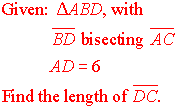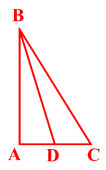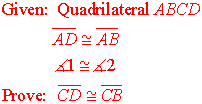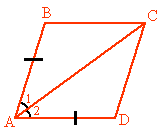A proof is a written account of the complete thought process
that is used
to reach a conclusion. |
Each step of the process is supported by a theorem, postulate, property or definition
verifying why the step is possible.
In formal Euclidean proofs, no steps can be left out.
If you think about the numerical problems you are used to solving in geometry,
you will realize that your mind often does a "fast-forward" through some of the logical steps needed to reach a valid answer. In other words, you quickly "go right to the answer."
Check out the numerical problem below:
Example of a Number
Problem
(your thinking
is in
"fast-forward") |
 |
 |
Answer: Since  bisects bisects  , D is the midpoint of , D is the midpoint of  , forming two congruent segments whose measures are equal. , forming two congruent segments whose measures are equal.
If AD = 6, then DC = 6 as well. |
You probably arrived at the answer of 6 long before you finished
reading the explanation of the answer. Right?
When developing a proof of this same problem, we must be careful
to include ALL of the steps that led to our answer.
We cannot "fast-forward" over steps when writing a proof.
Check out the "proof" of this same problem:
Proof of the
Same
Problem
(slow down your thinking) |
 |
 |
| Statements |
Reasons |
1.  |
1. Given |
2.  |
2. Segment bisector intersects a segment at its midpoint. |
3.  |
3. Midpoint divides a segment into 2 congruent parts. |
4.  |
4. Congruent segments are segments of equal measure. |
5.  |
5. Substitution. |
A proof requires that you document all of the little steps that you mentally
"fast-forwarded" through in the numerical problem.

What's in a proof?
A formal 2-column proof contains the following components:
Refer to the labeled proof below the chart.
• Statement of the original problem.
This information is usually stated in the original problem. Some word problems, however, have to be dissected in order to get the specific information needed for the proof. |
Part A |
• Diagram marked with "Given" information.
The diagram usually is not marked, so this step is very important. You will see the sought after congruent triangles and their corresponding parts much clearer with the diagram marked. |
Part B |
• Re-statement of the "Given" information in the proof.
Stating the "Given" information is almost always the first statement, and the reason is simply "GIVEN". |
Part C |
• Complete supporting reasons for each step in the proof.
The "wording" of supporting reasons may vary slightly between textbooks (and teachers), so be careful to follow the guidelines set by your teacher. |
Part D |
• The "Prove" statement as the last statement.
"PROVE" is always the final statement. This statement is the purpose for the entire problem. |
Part E |
See the parts labeled on the proof.
Labeled "Parts"
of the
Proof |
Part A:
 |
Part B:
 |
| Statements |
Reasons Part D: |
1.  Part C: Part C: |
1. Given |
2.  |
2. Segment bisector intersects a segment at its midpoint. |
3.  |
3. Midpoint divides a segment into 2 congruent parts. |
4.  |
4. Congruent segments are segments of equal measure. |
5.  Part E: Part E: |
5. Substitution. |

A Helpful Proof Strategy!
A helpful strategy is often "looking backward"!
For most proof
problems, it is helpful to think of the problem "in reverse",
from the "Prove" statement back to the "Given" information.
Ask "How could I get to this result?"
"What would I need to know to get to this result?"
Let's look at this strategy applied to the problem we just examined.
Looking
Backward
Strategy |
 |
 |
A look "backwards" -- Where could this conclusion come from?
By looking at the above steps, we can see how to proceed with the proof.
| Statements |
Reasons |
 |
1. Given |
 |
2. Reflexive Property - a quantity is congruent to itself. |
 |
3. SAS: If 2 sides and the included angle of one triangle are congruent to the corresponding parts of another triangle, the two triangles are congruent. |
 |
4. CPCTC: Corresponding parts of congruent triangles are congruent. |
You might want to consider jotting down your "backward"
thoughts before you begin writing your proof.

NOTE: The re-posting of materials (in part or whole) from this site to the Internet
is copyright violation
and is not considered "fair use" for educators. Please read the "Terms of Use". |
|




